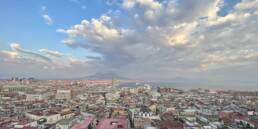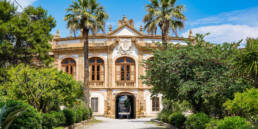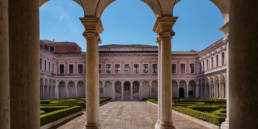Venice is a rare city that, despite being rather small and at the edge of a country, attracts international attention on a regular basis. Not only for its precarious ecological position and wealth of heritage to preserve, but for the presence of the modern cultural institution of the Biennale that regularly brings experts of art, architecture, theatre, dance, cinema and music to the lagoon.
The first international art exhibition was held in 1895, and currently the years alternate between art (every two years), and architecture with all the other “arts” in the other years. The Biennale di Architettura due to be held in 2020 was delayed by one year, upsetting the even/odd balance that alternated the dates in the past few decades.

So 2021 is an architecture year in Venice. It’s less glamorous and perhaps more studious than the contemporary art Biennale, attracting a more niche crowd, but it’s an important reflection both of its time and of the near future of the way we live, so if you have a chance, it’s worth visiting. I had a chance to do so earlier this summer, when I stayed at the fabulous Hayez Apartment at Palazzo Ca’Nova managed by Trust and Travel Villas, and wrote my luxury Venice itinerary. As the Biennale is open until the end of November and I know a number of people still plan to visit, I’m sharing my reflections and a short review.
The theme for the 2021 Biennale was decided in 2018, and most of the contributions were ready before 2020. So while the topic, posed as the question “How will we live together,” is actually pre-Covid, it’s an even more valid question now. Curator Hashim Sarkis tells Monocle that all the main reasons they asked this question initially “are the same reasons that led us to the pandemic: climate change, the rural-urban divide, political polarisation, inequity, mass migration and mass tourism.” The question is very carefully loaded. It asks for proposals or solutions (how), it asks about the future (will), it imagines a global collective (we), considers life on earth (live) and a concept of a global solution (together). Posed to architects and curators around the world, the result is an exhibition that asks more questions than provides answers, that explores possible solutions but leaves viewers, perhaps intentionally, wondering if, how and when any of the proposed ideas will come into common play.
How the Biennale di Architettura is set up

If you’ve never been to a Biennale, it’s helpful to know the lay of the land (it’s the same for architecture or art). The area called Giardini is the original nucleus of the exhibition, where there are the original national pavilions as well as one that contains the “main exhibit”, which is located to the left of the entrance at the end of the path. (This is also the handy location of the bathrooms.) In the giardini, the shade of trees provide welcome coolness, though mosquito repellent is a must. Depending on how much you like to read and reflect, you can spend 2-3 hours here, or even more. If your time is limited, you might only do this part.
The next part of the show is set up at the Arsenale, which requires you to exit the gardens beyond where you initially showed your ticket. Assuming hunger will be getting the best of you, if you can snag a table at the café located in the greenhouse to the right of the exit, eat there (they serve sandwiches, big salads, and quiches as well as your usual drinks and gelato). You’ll then walk a short way to the second part of the show. Once you enter this building, there are no further outdoor spaces, and no shortcuts if you want to skip a section (like jumping from say, home textiles to bathroom furnishings at IKEA). It’s worth mentioning that some of the Biennale’s official pavilions are located in rented buildings beyond these two main spaces. There are also off-Biennale activities around town.
Here’s what I thought of the architecture Biennale

More of an arts than an architecture person, myself, I observed a lot of overlap between contemporary art installations that make statements about living situations of migrants, about climate change, about urban problems and the like, and the way that the Biennale’s installations observe similar issues. This, I felt, was particularly the case in the “main exhibit”, divided into three parts over two spaces. At the Giardini, the themes of common goods and marginality are explored. At Arsenale, the exhibit looks at the rapport between humans and nature and space, which provided for interesting considerations of the needs of diverse bodies and extensions of nature-based solutions. It also looked at new ideas of households, and emergent communities.

For me, the winner in this section was a glass box in which you could smell an extinct Hawaiian plant and listen to the sounds of the forest that used to host it – I’m a big fan of discreet scents and enjoyed the immersive aspect. I don’t quite understand how they recreated the smell, so maybe it was all made up.

I enjoyed a section on developing self-contained communities, with its little mockups of mixed-use areas integrated with green spaces, some of which have really been created but all of which seem irresolutely utopian in contrast with the cities beyond them. There were also plenty of parts of this show that made my husband and I throw up our hands in bewilderment… I cannot say that I understood it all, and I don’t know if that is my fault or theirs.

As with the arts Biennale, perhaps the most “fun” part is exploring the national pavilions in the Giardini. These national pavilions were built starting in the 1930s and the most clever uses find ways to truly adapt the building each year to make a new statement. Denmark does just this, transforming their traditional building into one that makes a statement about the role of water, in Venice and beyond, by collecting rainwater, growing herbs, and serving herbal tea in a floating living room. It makes you think that it is possible to transform the concrete blocks we current live in into organic, healthier green spaces if we put our mind (and money) to it.

The Northern countries of Norway, Sweden and Finland share a pavilion in which they – aptly – created a common living space full of wood and organic elements that you are invited to enter in your stocking feet; due to Covid, I didn’t really feel up to doing so, though fully agree with the practise that I use also in my own home. This exhibit takes the curator’s question of how we can live together quite literally by (re)addressing the idea of commune, now called co-housing. Sustainable, open source and shared are the keywords and frankly this IS a good model in which no-frills apartments occupy an outer space, while shared services occupy a light-filled, central courtyard that encourages sociability. I think it’s beautiful and ideal, but also idealistic. I hate my neighbours, and cannot imagine sharing a space, or aesthetic, with them.
Particularly creative were the countries who were not able to come to Venice to work on their pavilions due to the pandemic. While some simply didn’t show up, others got creative. Japan sent over parts of a dismantled traditional house, numbered and with Ikea-like instructions to be followed remotely by Venetian builders, raising interesting questions about reuse and authorship.

Canada wrapped its pavilion in a green screen and developed a low-cost Instagram VR filter through which you can see Canadian locations being used in films and pretending to be other places. As usual, the Canadians “fake it til they make it.”
One thing I did not see treated at this Biennale was the question of workspaces and common spaces in the post-Covid era. These are pressing questions that shed some doubt onto projects like that of the co-housing proposed by the Scandinavians; I wonder how we can share spaces and services when we are to limit our contact with people beyond a certain “bubble,” and the practicality of shared kitchens, offices etc. in times of lockdown. The very real spread of populations beyond cities to the countryside and the consequent impact on infrastructure and social structures was also not treated. Perhaps this will be material for the 2023 edition.
The architecture Biennale is on in Venice until November 21, 2021. Advance ticket purchase required.
A short summary of this post has been published on the Trust & Travel blog.
Sign up to receive future blog posts by email
Alexandra Korey
Alexandra Korey aka @arttrav on social media, is a Florence-based writer and digital consultant. Her blog, ArtTrav has been online since 2004.
Related Posts
September 11, 2023
An art historian’s approach to things to do in Naples, Italy
June 22, 2023
4 day trips from Palermo up the Tyrrhenian coast
August 5, 2021




